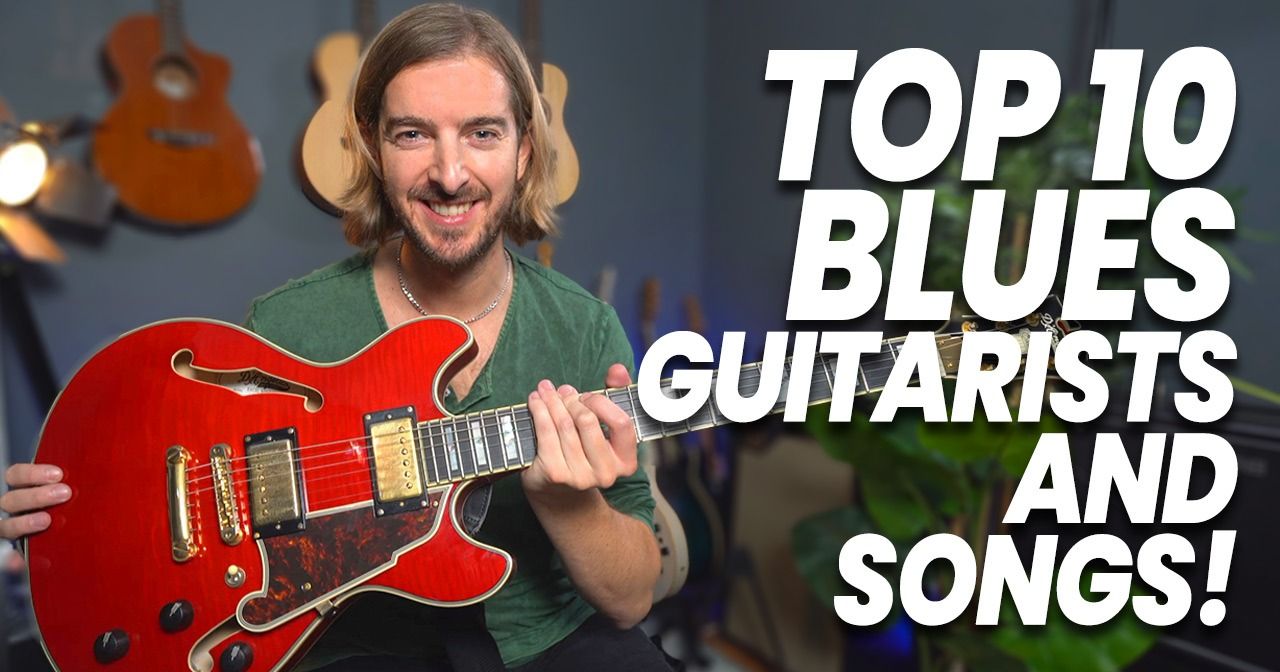In this video
This list covers the core lineage: the three Kings, T-Bone, Clapton, Green, Moore, SRV, Mayer, and Bonamassa — a timeline from 1940s roots to today.
From T-Bone’s jazz-infused swing to John Mayer’s polished modern tone, each of these guitarists represents a chapter in the evolution of blues expression — the shift from soulful minimalism to technical mastery, all while keeping the emotional core intact.
The blues guitar legends we'll be covering include;
B.B. King - lesson videos here
Freddy King - lesson videos here
Albert King - lesson videos here
T Bone Walker - lesson videos here
Eric Clapton - lesson videos here
Peter Green - lesson videos here
Gary Moore
Stevie Ray Vaughan - lesson videos here
John Mayer - lesson videos here
Joe Bonamassa
1. B.B. King (“The King of the Blues”)
View all Andy's B.B. King lessons here
Why iconic:
Refined, vocal-like phrasing — “playing like he’s singing.”
Defined the concept of taste and space in blues soloing.
His vibrato and bending are among the most imitated in guitar history.
Key Songs:
The Thrill Is Gone
Every Day I Have the Blues
Sweet Little Angel
Techniques:
Signature wide, slow vibrato (“B.B. Box” around the 10th fret).
Phrasing using call-and-response style.
Minimalism — a few perfect notes instead of flashy runs.
Guitar:
Gibson ES-355 “Lucille” — semi-hollow, no f-holes to reduce feedback.
2. Freddie King (“The Texas Cannonball”)
All Freddy King lesson videos here
Why iconic:
Powerful blend of Texas and Chicago blues.
Aggressive, raw tone and soulful vocals.
Bridge between traditional blues and early rock guitar.
Key Songs:
Have You Ever Loved a Woman
Hide Away
Going Down
Techniques:
Fingerpicking with metal thumb and plastic fingerpicks.
Explosive attack, string raking, and bends.
Melodic yet punchy phrasing that influenced Clapton, SRV, and others.
Guitar:
Gibson ES-345 or Les Paul Goldtop (early years).
3. Albert King (“The Velvet Bulldozer”)
Why iconic:
Left-handed player who flipped his guitar upside down — created unique string tension feel.
Deep bends, space, and phrasing inspired Clapton, Hendrix, SRV.
One of the “Three Kings of the Blues” with B.B. and Freddie.
Key Songs:
Born Under a Bad Sign
Crosscut Saw
Laundromat Blues
Techniques:
Huge, vocal-like string bends (often 2 or 3 semitones).
Sparse but powerful phrasing.
Use of minor pentatonic with expressive vibrato.
Guitar:
Gibson Flying V “Lucy” (1958 Korina model).
4. T-Bone Walker (“The Father of Electric Blues”)
Why iconic:
First to popularize electric lead guitar in blues.
Stage pioneer — behind-the-head tricks decades before Hendrix.
Brought jazz sophistication and swing to the blues.
Key Songs:
Call It Stormy Monday (But Tuesday Is Just as Bad)
T-Bone Shuffle
Mean Old World
Techniques:
Jazz-influenced chord voicings and turnarounds.
Smooth, horn-like phrasing.
Early use of double stops and vibrato.
Guitar:
Gibson ES-250 / ES-5 archtop hollow bodies.
Related Innovators:
Sister Rosetta Tharpe – gospel roots + distorted electric tone.
Chuck Berry – merged blues phrasing with rock rhythm and showmanship.
5. Eric Clapton
Why iconic:
The first British guitarist to become a “guitar god.”
Bridged Delta blues, Chicago blues, and rock.
Constant reinvention: Bluesbreakers → Cream → solo success
Key Songs:
Crossroads (Cream)
Layla (Derek & the Dominos)
Wonderful Tonight
Techniques:
Singing sustain with tone control.
Smooth phrasing, hybrid pentatonic + major blend.
Slowhand touch — expressive vibrato and bends.
Guitar:
Fender Stratocaster “Blackie”, early years: Gibson Les Paul (Beano burst).
6. Peter Green (Fleetwood Mac founder)
Why iconic:
Deeply emotional, lyrical blues phrasing.
Created hauntingly beautiful, minimalist lines.
Understated playing influenced generations.
Key Songs:
Albatross
Black Magic Woman
Need Your Love So Bad
Techniques:
“Out-of-phase” tone from reversed pickup magnet.
Soulful bends, gentle vibrato.
Phrasing filled with space and sadness — pure emotion.
Guitar:
1959 Gibson Les Paul Standard (famously modded, later owned by Gary Moore).
7. Gary Moore
Why iconic:
Fusion of Irish passion and blues firepower.
Incredible sustain, tone, and emotional attack.
Bridged classic blues with ‘80s rock edge.
Key Songs:
Still Got the Blues
Parisienne Walkways
Empty Rooms
Techniques:
Long, vocal bends and wide vibrato.
Sustained notes with smooth legato phrasing.
Dynamic touch — whisper to wail.
Guitar:
Gibson Les Paul Standard (Peter Green’s old guitar).
8. Stevie Ray Vaughan
Why iconic:
Revived blues in the ‘80s with raw Texas power.
Combined Hendrix fire, Albert King phrasing, and soul grit.
Known for relentless intensity and groove.
Key Songs:
Pride and Joy
Texas Flood
Little Wing (cover)
Techniques:
Heavy strings (.013s), huge bends, fast blues shuffles.
Double-stops, rakes, and aggressive attack.
Tremolo bar subtlety and dynamic control.
Guitar:
Fender Stratocaster “Number One” (‘59/’62 hybrid).
9. John Mayer
Why iconic:
Modernized blues for mainstream pop/rock.
Combines SRV tone with jazzy sophistication and pop songwriting.
One of the few contemporary players to bring blues back to radio.
Key Songs:
Gravity
Slow Dancing in a Burning Room
Who Did You Think I Was
Techniques:
Thumb-over chord voicings, percussive fingerstyle.
Smooth bends and phrasing, modern blues-pop hybrid.
Mixolydian and major/minor pentatonic blend.
Guitar:
PRS Silver Sky (modern) / previously Fender Stratocaster signature.
10. Joe Bonamassa
Why iconic:
Modern blues-rock ambassador, virtuosic technique.
Massive vintage gear collection and tone obsession.
Known for channeling Clapton, Page, and BB King influences into arena-level blues.
Key Songs:
Sloe Gin
The Ballad of John Henry
Driving Towards the Daylight
Techniques:
Hybrid picking, fast pentatonic runs, precise vibrato.
Incorporates rock dynamics and showmanship into blues phrasing.
Powerful control of dynamics and tone.
Guitar:
Gibson Les Paul Standard, also ES-335, Flying V, and custom models.

